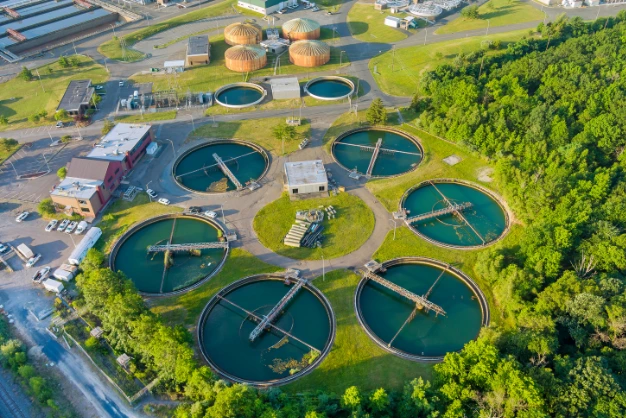TABLE OF CONTENTS
TABLE OF CONTENTS
Access to clean and safe water is a fundamental need, and water treatment chemicals play a critical role in ensuring this. Whether it’s for municipal use, industrial water treatment chemicals applications, or residential purposes, these chemicals help remove contaminants, improve water clarity, and protect public health.
In this guide, we will explore the most commonly used water purification chemicals , their functions, and how they contribute to effective water filtration and treatment processes.
What Are Water Treatment Chemicals?
Water treatment chemicals are substances added to water to purify it by removing impurities, pathogens, and harmful substances. These chemicals are essential in both drinking water and wastewater treatment systems. They help:
- Neutralize pH levels
- Remove suspended solids
- Disinfect against bacteria and viruses
- Prevent corrosion and scaling in pipes
Different types of chemicals for water treatment exist depending on the source (groundwater, surface water, or wastewater) and intended use (drinking, irrigation, industrial processes).
Top 10 Most Commonly Used Water Treatment Chemicals
Here’s a list of the most widely used water treatment chemicals , along with their roles in the purification process.
1. Chlorine (Cl₂)
Overview
Chlorine is one of the most widely used water purification chemicals globally due to its effectiveness in disinfecting water.
Function
- Kills bacteria, viruses, and other pathogens
- Oxidizes iron, manganese, and hydrogen sulfide
- Provides residual protection against microbial regrowth
Application
Used in municipal water treatment plants, swimming pools, and emergency water purification kits.
2. Chloramines (NH₂Cl)
Overview
Chloramines are formed by combining chlorine with ammonia and serve as an alternative to free chlorine.
Function
- Longer-lasting disinfectant than chlorine alone
- Reduces formation of harmful DBPs
- Effective against bacteria and viruses
Application
Preferred for large distribution systems where water remains in pipes for long periods.
3. Alum (Aluminum Sulfate – Al₂(SO₄)₃)
Overview
Alum is a coagulant commonly used during the initial stages of water treatment.
Function
- Neutralizes negative charges on suspended particles
- Causes fine particles to clump together (flocculation)
- Removes turbidity, color, and some organic matter
Application
Widely used in surface water treatment plants dealing with high levels of particulates.
4. Ferric Chloride (FeCl₃)
Overview
Another popular coagulant, ferric chloride works similarly to alum but performs better at lower pH levels.
Function
- Removes suspended solids and phosphorus
- Effective in cold water conditions
- Enhances sludge dewatering in wastewater
Application
Used in both potable and industrial wastewater treatment.
5. Activated Carbon
Overview
A physical/chemical filter media often classified among water filtration chemicals.
Function
- Adsorbs organic compounds, chlorine, and taste/odor-causing substances
- Reduces volatile organic compounds (VOCs)
- Improves aesthetic qualities of water (taste, smell)
Application
Used in granular activated carbon (GAC) filters or powdered activated carbon (PAC) dosing systems.
6. Lime (Calcium Oxide – CaO)
Overview
Lime is primarily used to adjust pH and soften water.
Function
- Raises pH to reduce acidity
- Softens hard water by precipitating calcium and magnesium
- Aids in coagulation and metal removal
Application
Used in lime softening and corrosion control programs in municipal systems.
7. Fluoride (Sodium Fluoride – NaF)
Overview
Fluoride is added to drinking water to promote dental health.
Function
- Strengthens tooth enamel
- Prevents tooth decay in children and adults
Application
Municipal water supplies often fluoridate water at concentrations between 0.7–1.2 mg/L.
8. Sodium Hydroxide (Caustic Soda – NaOH)
Overview
Also known as caustic soda, sodium hydroxide is used to control pH and alkalinity.
Function
- Increases pH to neutralize acidic water
- Stabilizes water to prevent pipe corrosion
- Enhances coagulation efficiency
Application
Commonly used in water softening and advanced oxidation processes.
Tip
Highly caustic; must be handled with protective gear and proper dilution.
9. Ozone (O₃)
Overview
Ozone is a strong oxidizing agent used in advanced water treatment systems.
Function
- Destroys microorganisms and viruses
- Breaks down organic pollutants and pharmaceutical residues
- Leaves no chemical residue
Application
Used in bottled water treatment, high-end municipal systems, and food processing.
10. Polyacrylamides
Overview
These synthetic polymers act as flocculants to enhance particle removal.
Function
- Binds small particles into larger flocs
- Improves sedimentation and filtration efficiency
- Helps reduce sludge volume
Application
Used in both potable water and wastewater treatment plants.
The Importance of Chemicals in Water Treatment
Water treatment involves multiple stages—each requiring specific water purification chemicals . Here’s how they contribute at each stage:
1. Coagulation and Flocculation
In this stage, chemicals like aluminum sulfate (alum) and ferric chloride are used to bind small particles together into larger clumps, making them easier to remove.
2. Sedimentation
After flocculation, gravity helps settle the heavier particles at the bottom of the tank. No additional chemicals to treat water are needed here, but prior chemical use is vital.
3. Filtration
Filtration removes remaining fine particles. While physical filters are key, some water filtration chemicals like activated carbon can enhance removal of organic compounds and chlorine taste/odor.
4. Disinfection
This final step uses powerful agents like chlorine, chloramines, or ozone to kill any remaining pathogens. Proper disinfection ensures water is safe for consumption.
What Is Filtration in Water Treatment?
Filtration in water treatment refers to the physical or chemical process of removing particulate matter, suspended solids, and certain dissolved impurities from water using barriers or media such as:
- Sand filters
- Granular Activated Carbon (GAC)
- Membrane filters (e.g., ultrafiltration, reverse osmosis)
The goal is to improve water clarity, reduce turbidity, and remove potentially harmful substances that could affect health or damage infrastructure.
While filtration chemicals aren’t always required during this phase, they can enhance performance. For example:
- Activated carbon improves taste and odor.
- Ion exchange resins remove heavy metals.
- Ozonation before filtration boosts microbial control.
Filtration is a crucial barrier against pathogens and pollutants, especially in surface water treatment.
Conclusion: Invest in Quality Water Treatment Chemicals
Investing in the right water treatment chemicals is not just about compliance—it’s about protecting public health, preserving infrastructure, and ensuring sustainability. From basic disinfectants to advanced filtration aids, every chemical plays a unique role in delivering clean, safe water.
Whether you’re managing a municipal plant, overseeing industrial operations, or simply curious about home water treatment, understanding these chemicals empowers you to make informed decisions.
Get in touch with RawSource — your reliable commodity and chemical supplier.
Frequently Asked Questions (FAQs) About Water Treatment Chemicals
What is the list of water treatment chemicals?
Here’s a comprehensive list of commonly used water treatment chemicals :
- Chlorine : A primary disinfectant used to eliminate bacteria, viruses, and other harmful pathogens.
- Chloramines : Often used as an alternative to chlorine, chloramines provide long-lasting disinfection with fewer disinfection byproducts.
- Alum (Aluminum Sulfate) : Acts as a coagulant, helping to remove turbidity, color, and suspended solids from water.
- Ferric Chloride : Another coagulant that works effectively in acidic or cold water conditions.
- Lime (Calcium Oxide) : Used to adjust pH levels and reduce water hardness through softening processes.
- Sodium Hydroxide : Helps regulate alkalinity and prevents pipe corrosion by stabilizing water chemistry.
- Activated Carbon : Removes taste, odor, chlorine, and volatile organic compounds (VOCs), improving the aesthetic quality of water.
- Ozone : A powerful oxidizing agent used in advanced treatment systems for disinfection and contaminant breakdown.
- Fluoride : Often added to public drinking water supplies to support dental health.
- Polyacrylamides : Flocculating agents that help small particles clump together, making them easier to remove during sedimentation and filtration.
- Phosphates : Used as corrosion inhibitors and scale control agents to protect distribution piping.
- Hydrogen Peroxide : An oxidizing chemical used for odor control and advanced oxidation processes.
What are the best water treatment chemicals for drinking water?
For drinking water treatment , the following chemicals are essential:
- Chlorine/Chloramines : Disinfect pathogens
- Alum/Ferric Chloride : Remove turbidity and color
- Activated Carbon : Eliminate taste and odor issues
- Fluoride : Promote dental health (optional depending on region)
- Lime/Sodium Hydroxide : Adjust pH and prevent pipe corrosion
These ensure that water meets regulatory standards for safety and aesthetics.
What are two common chemicals used to purify water?
The two most commonly used chemicals for water purification are:
- Chlorine – widely used for disinfection due to its effectiveness and affordability
- Activated Carbon – used to remove organic compounds, chlorine, and unpleasant tastes/odors
These are often used together in multi-barrier treatment systems.
Which are the best water treatment chemicals available?
The "best" chemical depends on the application, but top performers include:
- Chlorine – cost-effective and proven disinfectant
- Ozone – strong oxidizer without leaving residues
- Activated Carbon – excellent for removing organics and improving aesthetics
- Ultra-pure Alum – efficient in removing turbidity
- Corrosion Inhibitors (e.g., Phosphates) – protect infrastructure
Always consult with a certified water treatment specialist to determine the optimal chemical blend for your system.
Proper chemical management ensures efficient operation and extends equipment life.
Contact Us
Questions or looking for a quote?





